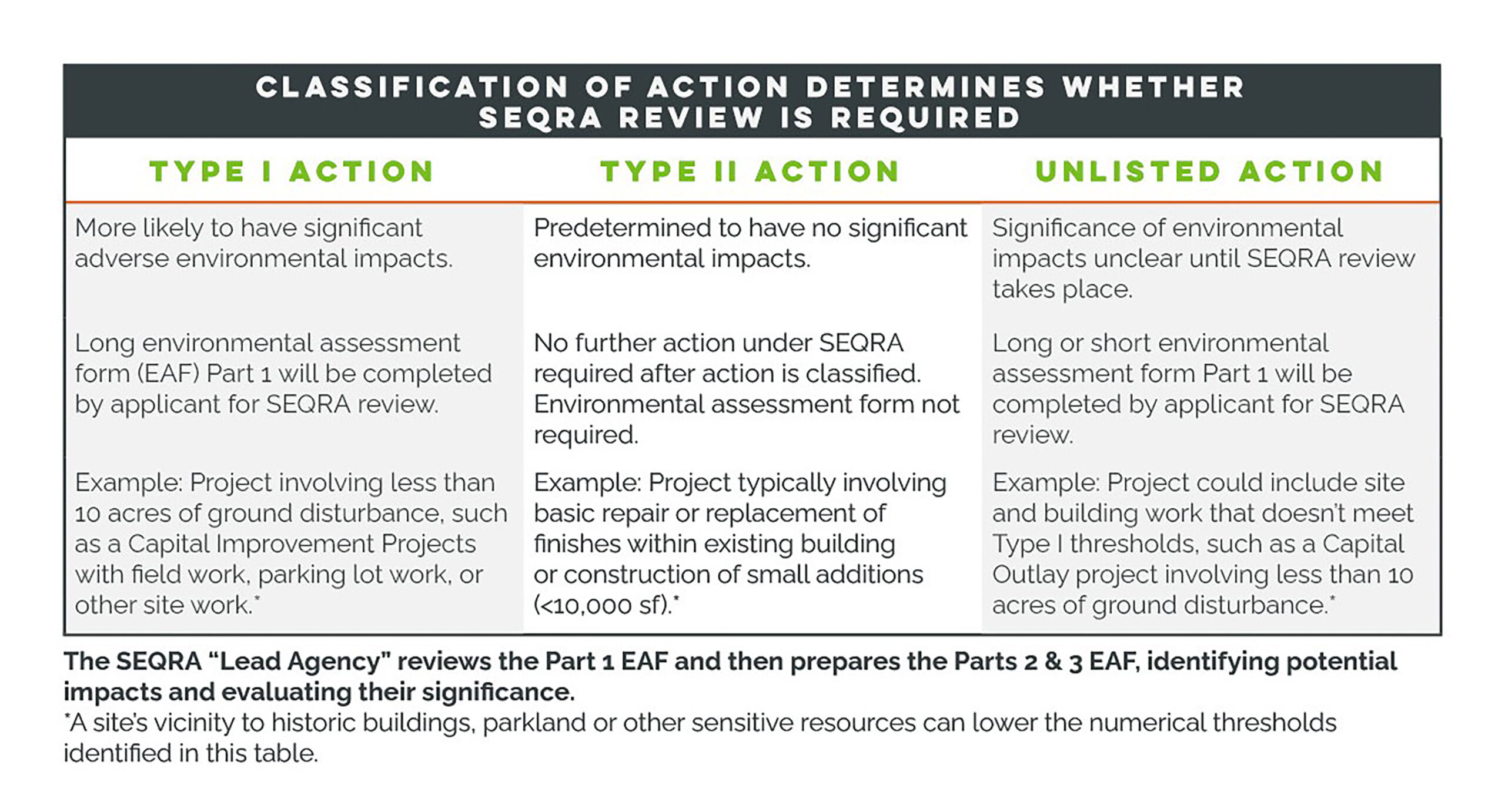Simplifying SEQRA for School Districts

The State Environmental Quality Review Act (SEQRA or SEQR) requires school districts as well as local, regional, and state agencies to review the potentially significant environmental impacts of their actions prior to the start of projects. While some may consider SEQRA to be confusing, stressful, and potentially cause project delays, the SEQRA compliance process can be manageable when expectations are set early during the process. This article will help you understand the SEQRA process and how to keep it from slowing down a project.
Actions undertaken by, funded by, and requiring discretionary approvals from local, regional, or state agencies are subject to SEQRA. When a project involves funding or approval by the New York State Education Department (NYSED), for example, SEQRA review is triggered. The Lead Agency is the agency responsible for SEQRA compliance. In most cases, the school district’s Board of Education (BOE) acts as the Lead Agency for school district project SEQRA reviews. As Lead Agency, the BOE is responsible for preparing the SEQRA documents for NYSED.
The SEQRA process varies based on the scope of the project and can take anywhere from one month to over a year. The scope of the project dictates the SEQRA classification and ultimately the timeline of the SEQRA review. At least six months ahead of the referendum vote, LaBella will review the project scope and determine the level of SEQRA review needed. LaBella will contact the district’s SEQRA Attorney to confirm the SEQRA classification and timeline.
Capital Improvement Projects are often classified as Type I Actions given the extensive amount of site work proposed. Capital Outlay Projects and other smaller projects are often classified as Unlisted Actions. Type II Actions such as the replacement of finishes on existing buildings are exempt from SEQRA. The table below outlines the three different types of SEQRA classifications (including project examples) and general requirements.

Type I Action
Approximately five to six months ahead of the referendum vote, LaBella will prepare Part 1 of the Environmental Assessment Form (EAF), identifying any potentially sensitive environmental resources in the project area such as wetlands, floodplains, threatened or endangered species, and archaeological or historic resources. If needed, additional studies will be performed such as a wetland delineation, a traffic study, a threatened/endangered species habit survey, a historic resource survey, or an archaeological survey. Performing this work early on will save time and money and could avoid the need for additional studies, permits, or approvals.
Type I Actions require a coordinated review. As part of the coordinated review process, the EAF Part 1 will be circulated to the local, regional, or state agencies providing funding, permits, or other approvals for the project (i.e., New York State Department of Environmental Conservation, New York State Department of Transportation, New York State Historic Preservation Office, local planning boards, county Department of Transportation, etc.). These potentially involved and interested agencies are put on notice about the BOE’s intention to serve as Lead Agency, and they may provide comments about the project. The timeframe for coordinated review is 30 days.
Approximately three to four months ahead of the referendum vote, LaBella will prepare Parts 2 and 3 of the EAF, analyzing potential environmental impacts and determining any potential mitigation measures. At least 30 days after the EAF Part 1 is circulated, the BOE will issue their determination for the SEQRA review (the goal is a Negative Declaration or finding of no significant environmental impacts). The Negative Declaration will then be circulated to local and state agencies. The referendum vote must occur at least 45 days after the Negative Declaration is circulated to the involved and interested local, regional, and state agencies.
Unlisted Action
For Unlisted Actions, a coordinated review is optional but is typically recommended because school district projects often require multiple permits and approvals. Conducting a coordinated review is ultimately up to the discretion of the BOE, as Lead Agency, and their counsel. If an Unlisted Action undergoes a coordinated review, the timeline is nearly identical to a Type I Action. However, for an uncoordinated review, the timeline would be shortened. So, around four to five months ahead of the referendum vote, LaBella will prepare Parts 1, 2, and 3 of the EAF. At a single meeting, the BOE will issue their determination of significance for the SEQRA review (the goal is a Negative Declaration). The referendum vote must occur at least 45 days after the Negative Declaration is issued.
Type II Action
For Type II Actions, which are exempt from SEQRA review, a memorandum is prepared by LaBella detailing why the project meets Type II criteria under SEQRA. It is optional – but good practice – for the BOE to also pass a resolution explaining the Type II classification so that it is on the record.
Key Takeaways
- Connect with LaBella early in the planning process to identify potential environmental concerns.
- From the beginning, focus on designing projects to avoid sensitive environmental resources. This will save time and money and could avoid the need for additional studies, permits, or approvals.
- SEQRA can be relatively pain free when the timeline is set early and sufficient time is allowed for additional studies (i.e., wetland delineations, archaeological surveys, traffic impact studies, etc.).
*Check out a visual representation of the SEQRA Milestone Timeline in the Spring 2023 issue of In Session, our K-12 Digest that offers some reminders and tips on the SEQRA process as well as wetland delineations, closing out SWPPPs, and more!
Spring 2023 Issue of In Session

About the Author
Alexandra SchutzerEnvironmental Analyst
Alexandra is an Environmental Analyst with experience in environmental impact analysis and compliance with a specialized focus on state and federal environmental regulations under SEQR and NEPA. Alex has prepared SEQR Environmental Assessments for a wide range of community and private development projects throughout New York State, including new construction, adaptive re-use and rehabilitation, renewable energy, public utilities, and school district capital improvement projects. She has also prepared countless NEPA Environmental Assessments for a variety of rehabilitation and new development projects in support of environmental compliance under various federal agencies, with a particular expertise in HUD-funded affordable housing projects. She addresses concerns regarding water resources, farmland, historic and archaeological resources, remediation, and noise impacts.